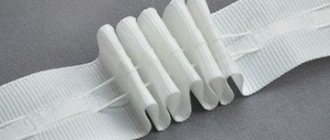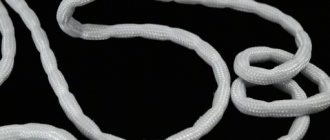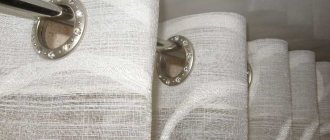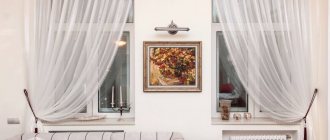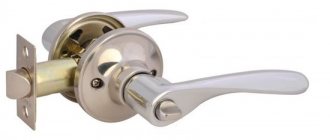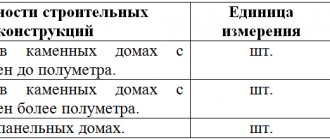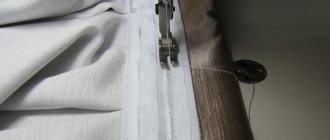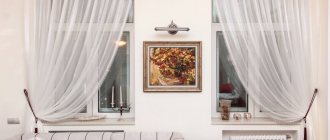With the appearance of braid on store shelves, the question of how to properly hang curtains using it has become relevant and timely. For the convenience of housewives, manufacturers offer different methods, instructions and fastening techniques. Mounting tape is a fresh solution for textile design. And curtains are a detail that creates comfort. Selecting a canvas is a half-solved task. Making uniform drapery without disturbing the design and getting aesthetic pleasure from the work done - this is the answer to the task.
Curtain tape for curtains and tulle
Curtain tape resembles a ribbon and can be white or colorless.
Along its entire length there are parallel ropes, and in the middle there is a dense layer with loops for hanging the curtains to the fixing device. Curtain tape consists of fabric strips of different widths, along the entire length of which thin ropes or laces are stretched in one or several parallel rows.
The material for curtain tape can be either natural or synthetic fabrics of different densities.
Curtain tape is a special type of soft decorative fittings used to form curtain folds of various sizes and shapes. This is a kind of framework for all variations of assemblies. With the advent of tape, securing curtains has become much easier and more convenient. There is no longer any need to attach metal clips that damage the base or sew on eyelets manually. In total there are approximately 70 varieties of braid.
In the middle of the tape there is a denser layer with loops designed for hanging curtains from a baguette, and ropes are used to create gathers of the desired shape and size.
They differ in the following characteristics.
- Fixation methods. These can be eyelets, loops for hooks, strings, pipes, as well as sticky stickers.
- Fold configuration There can be many options here, which depend on the wishes of the customer or the imagination of the author.
- Dimensions. Braid from 1.5 to 10 cm is considered standardized. 2.5 and 6 cm are more in demand.
- Material. For draping airy organza and veils, fishing line is used, and for thicker, weighty textures, polyester, cotton and paper are used.
After tightening the laces, folds form on the surface of the curtain; they can be given the desired shape.
To remove the curtains, you just need to untie the laces and straighten the tape.
IMPORTANT! Curtain tape is sewn from both natural and artificial fabrics of varying densities. The braid, sewn from rigid materials, holds its shape perfectly
Types of braid
And there are variations here. Curtain braid can be:
- Narrow up to 4 cm and wide up to 15 cm.
- They differ in the number of broaches of pockets for hooks.
- Different folding coefficients: starting from 1.5 and ending with 3. The frequency of folds depends on the value of the coefficient.
- Sew-on – secured to the curtain using a sewing machine.
- Some types of braid are glued to the curtain with a hot iron.
- It is attached to the cornice using Velcro and loops.
The material from which the curtain tape is made is polyester. It adheres to the curtain fabric at literally every point and prevents the material from sagging and deforming. Loops are sewn to the tape along its entire length, to which the hooks of the cornice cling. In addition, the curtain tape may include:
- Eyelet rings;
- Pockets in case of fastening with hooks;
- Seals;
- Cords in the amount of two to four pieces.
If you need simple gathers on the curtain, use hooks that are threaded into pockets or loops. If the material is heavy, the hooks are made of brass; for light materials, plastic hooks are sufficient. There are varieties of special hooks that are used to form triple or bow folds.
If one row of loops forms simple folds, then 3-4 rows form folds of a complex configuration.
When choosing a ribbon, you should take into account its length, which depends on the size of the folds you want to have on the curtain.
Step-by-step instructions for using curtain tape on hooks
To decorate a room, it is important to know how to hang curtains with tape on a rod for a more durable “fit.” The product can already be sewn industrially, or it can be attached independently
In order for the finished composition to hold firmly, it is important to know the order of its design and choose the right braid, taking into account such an indicator as the assembly coefficient.
The KS determines the “pitch” of the fastenings, depending on the width, which matters for the number of assemblies and their splendor.
When hanging curtains, it is important to sew the hook tape correctly. This operation is performed as follows:
- cut off a piece from the strip equal to the length of the curtain plus an increase of five centimeters;
- lay the ends of the braid down 2.5 cm each and smooth them;
- pull out the cords so that they hang freely and are not secured;
- place the tape over the allowance for the top trim and pin;
- stitch, retreating 12 mm from the top and bottom, stitch twice.
If the curtain tape has several ropes, we sew it along each of them.
Important! It is necessary to stitch in such a way as to close the fold so that the cords remain free. Then, stepping back 10cm from the side edge, you need to hang a hook - it will be the outermost one
Having folded the curtain along this hook, the next one is hung on two loops at once - the outermost one and the one opposite it. This action is called a technical twist. It can be done differently: tuck it in immediately when the strip is sewn on
Then, stepping back 10cm from the side edge, you need to hang the hook - it will be the outermost one. Having folded the curtain along this hook, the next one is hung on two loops at once - the outermost one and the one opposite it. This action is called a technical twist. It can be done differently: tuck it in immediately when the strip is sewn on.
The folds obtained on the braid after tightening the ropes should be evenly leveled.
The next element is threaded into the loop close to the collar, and it is threaded into the second one - after five centimeters. The result should be a fold. Further formation of drapery using curtain tape on hooks is done in a similar way.
Curtain tape is a convenient device used on any curtain, curtain or drapery.
How to choose the width of the curtain and the length of the curtain tape
In the process of determining the width of the finished curtain, it is necessary to take into account 2 points: the length of the curtain rod, as well as the so-called gathering factor. The latter depends on the type of folds. So, for example, if you plan to make a simple, even drapery, the coefficient will be 2.0, and if there are curly folds - 2.5. This indicates that in the first case, to determine the width of the finished curtain, the length of the cornice needs to be multiplied by 2.0, and in the other - by 2.5.
It is much easier to calculate the length of the braid. Since it is attached along the top edge, the length of the fabric strip should correspond to the width of the curtain without folds + 8 cm for the hem.
The size of the braid is easy to determine
Secrets of choosing the right curtain tape for tulle
In order to get the expected result with minimal effort, you need to choose the right accessory. It is enough to know a few simple conditions:
- The tape can be secured to the canvas not only by machine stitching; curtain tapes with an adhesive base, which are fixed during heat treatment, are also widely known. They are precisely intended for thin gas material. This braid will perfectly hold tulle and its like.
- Depending on the shape created by the curtain composition, a tape with loops, a seal or pockets for hooks is used.
- The width and transparency of the fabric play an important role when choosing curtain tape. For tulle, a narrow, porous, almost invisible braid is most suitable.
- It is also necessary to take into account the number of cords running through the tape and the required intensity of drapery. This must be correctly compared with the size and quality of the material so that the resulting folds look harmonious.
Decor options
Drapery consists of different fold options. They can be laid to one side at equal intervals (this is one of the simplest options).
If you want to create something original, you need to use your imagination and play with the canvas. The folds can be laid towards each other (counter), or vice versa, using paired bends to form flat bows.
The thickness of the tape and the number of cords for broaches depend on the method of decoration and the density of the fabric. Some options are formed directly on the cornice after the curtain is already hanging. This creates loop-shaped folds. The main thing is to maintain the same distance between them.
Beautiful drapery of curtains is obtained if you use a special thin cord to form folds. This option is called Flemish. You can lay folds in the form of geometric shapes. For example, buffalo ones resemble diamonds.
Methods for attaching weights
If you wish, you can sew your own curtains with additional weights. A load, fabric to match the color of the curtains, a sewing machine, threads, and scissors are prepared in advance. Measurements are taken with a measuring tape or tape measure. The method of attaching coins or wire depends on the weight of the web.
Tulle and lightweight materials - use weights weighing 12-22 grams.
The sequence of internal fastening of the weighting material to the lightweight fabric:
- If the curtain is light in weight, it is recommended to sew the strips on the sides. It is enough to take 2 parts weighing no more than 22 grams.
- Each element must be placed in a fabric pocket, which is sewn separately.
- A small cut should be made on the back side of the bottom hem of the curtain, keeping an interval of 5 cm from the bottom. If the material is not tucked, then it is allowed to use curtain tape.
- A pocket with a weighting agent is inserted into the resulting cut and sewn to the curtain.
To insert the parts, preliminary preparation of the bottom edge or side of the curtain is required.
When the curtain is made of dense, heavy material, the weight needs to be sewn in in a different way. On the reverse side at the bottom there are several pockets into which coins or metal balls are inserted. The folded bottom of the curtain can serve as a place for placing the parts.
Curtain tape is sewn to cover the holes
It is important to secure the weights so that they do not fall out when the curtain is in an upside-down position. To fix a wire or chain, you must first fold the fabric 10 cm and stitch it
A weighting agent is threaded into the resulting hole.
To prevent the load from shifting, the side edges of the hem are sewn up.
It is not necessary to sew a special pocket to fix the curtains in one position. Frequently, loads are attached to the outside of the curtains. In this case, weights for curtains or products with holes are used. From scrap materials, old coins will come in handy. The bottom of massive curtains is decorated with fringe or pendants, but such a detail is appropriate in classic or retro-style interiors.
Another weighting option in the form of a special fringe sheet attached to the bottom is suitable for massive heavy curtains.
The weighting material on organza curtains does not need to be placed in a special pocket. Here a special cord is used to match the curtains and is sewn on the back side of the fabric. It is prohibited to use chains and slats for curtains made of organza.
To sew weighting to organza, the material chosen for balancing is sewn directly to the bottom edge without forming a pocket.
Advantages of curtain tape
This strip is made from different materials. For curtains made of thin fabrics: organza, veil and others, a transparent, soft, thin but durable material is used. To work with denser bases, the thickness and texture of the braid will be different. It is easy to stitch it on a machine in any part of the product, depending on the design ideas for the curtains.
A very convenient device for draping curtains is curtain tape.
With its help, you can form folds of various configurations, adjusting their size and number. It has the following features:
- makes sewing easier;
- there is no need to sew loops for hooks - they are already on the tape;
- makes it possible to drape fabric of any texture and density;
- allows you to design window openings in an original way;
- with its help you can adjust not only the length, but also the width of the curtains.
Using curtain braid, beautiful folds of the same size and shape are created.
In addition, after washing it does not shrink and retains its shape.
Using a curtain strip, you can carefully trim the edge and attach the finished curtain to the curtain rod without using special clothespins.
The products are presented in a variety of options and differ in the methods of fastening, size, and shape of folds, which can be designed using your imagination.
They are made from fishing line, polyester, non-woven base.
There are also different connection methods, one of which is fastening loops for hooks.
They are arranged not only in one, but in several rows. The design features of the drapery depend on this:
- simple folds are made on a strip with two rows of loops;
- The upper part of the curtain can be decorated with a strip with four-row installation of fasteners.
You can attach the strip to the curtain by sewing or gluing it.
In this case, the adhesive tape is available in single-sided and double-sided versions. In this case, it is attached to the curtain fabric after smoothing the base with an iron.
The different widths of the tape - from 1.5 cm to 10 cm - allow you to use it for various options for fastenings and curtains of different lengths and materials, as well as diversify the methods of decoration.
The narrower the ribbon, the lighter the fabric should be.
It helps to perform all kinds of assemblies, including:
- horizontal;
- vertical;
- “accordion” and other drapery options, such as “pencil”, “glass”, “butterfly”, “bouffe”, “tulip”, fan-shaped and others, where curtain tape is used everywhere for installation on hooks.
There are several types of curtain tapes on sale, each of which is designed to assemble the fabric in the desired way.
There are other types: zigzag, tubes, “triplets”. Each type of curtain tape is made from different materials and has a parameter called the assembly factor (CS). It is the ratio of the original width of the curtain to the folded width, and is usually equal to 1.5; 2; 2.5 and 3. (KS) is usually indicated on the product packaging.
The wide ribbon has several rows of hooks that allow you to hang the curtain higher than usual, raising the fabric above the curtain rod.
Curtain rod tape: description, functions, photo
- Eyelet. It is made of nylon material, on the surface of which a layer of glue is applied. With its help, you can install rings made of plastic or metal on the curtain. Its use is not necessary, but it is desirable: curtains with grommet curtain tape do not deform after washing and will last much longer.
- For pipe cornices. Depending on the diameter of the pipe, the width of the curtain rod strip is selected. On the wrong side of the tape there are threads sewn in, which are strung at equal distances onto a pipe cornice.
The tape makes it possible to adjust the width and length of curtains without resorting to radical methods of cutting and hemming the fabric.
- For string cornice. This is a structure with a stretched thin wire on which the curtain is pulled using a special tape.
- Tape with hooks and Velcro. An excellent option for heavy curtains. The sticky part is attached on one side to the fabric. Hooks serve as a strong connection between the cornice and the fabric.
- Velcro tape. It is preferable to use for curtains with a vertical type of assembly. This type can withstand significant weight, even with the use of a lower weighting material.
- With magnet. On a strip of tape of small width, small magnets are fixed at equal distances from each other.
How to properly prepare the material
In order to be able to beautifully sew a ribbon to a curtain or tulle, and the result of the work will not disappoint you, you need to familiarize yourself with some of the subtleties of the process. When bending the tape, leave 3 cm on each side. Since this braid shrinks, it is measured with a reserve and then carefully steamed. The same is done with the fabric to which the fittings will be sewn. In this case, you can no longer expect negative consequences from shrinkage. The tape must be sewn loosely; neither the threads nor the material should be pulled.
When choosing a tape, you need to carefully examine the product, and if you see its large waviness, then you can already conclude that the quality of this material is low. Such fittings will not last long and will quickly become unusable.
Tips from an experienced seamstress
The following advice from an experienced craftswoman will help you sew the ribbon to the curtains correctly and avoid the need for rework:
- 2 threads are threaded into the machine: colored, suitable for curtains, and white;
- to prevent shrinkage, it is advisable to wet the curtain fabric and tape before use in warm water and dry it;
- It is better to hem all sections of fabric. If the braid is hemmed inside out, the top cut of the curtain fabric will be inside the hem. In this case, to prevent thread spillage, you can simply overcast it;
- before sewing the ribbon, you should definitely check for loops on the desired side, because there is always a risk of sewing it incorrectly;
- so that the free ends of the ropes after draping do not spoil the overall appearance of the curtain, they are hidden in secret pockets on the inside of the curtain;
- if for a ribbon 1.5–2 cm wide, 2 lines are enough - at the top and bottom, then for wider ones you will need 3–4;
- It is not necessary to secure the thread at the end of each line. At the end of the work, they can simply be assembled into one unit.
The ends of the cords are hidden in a pocket
How to sew curtain tape?
How to properly sew ribbon to a curtain? It's not difficult at all. You will need a sewing machine, thread, needle, scissors and iron.
- Measure the required length of the braid, leaving an allowance for embedding of 4-5 cm.
- The top edge of the curtain is folded 2-3 cm and ironed. If the fabric is fraying a lot, it is advisable to overcast the edge with an overlock stitch.
- Apply the tape with the wrong side to the wrong side of the curtain on the folded edge, retreating from the top 0.5-1.5 cm, depending on the type of assembly. The minimum indentation is made for simple assembly or for narrow braid without assembly. Make sure that the loops (pockets) are on the outside.
- The end of the curtain tape is folded in 2–2.5 cm. The ends of the cord are pulled outward so as not to accidentally sew them to the curtain.
- Sweep with large stitches.
- Place two lines on the edge: first the top, then the bottom. The number of lines depends on the number of cord lines. The braid is stitched along each cord or oriented according to the width of the braid: up to 5 cm - two lines, 5-10 cm - three lines, more than 10 cm - four lines. Stitch pitch length is 4-5 cm.
- The ends of the cords are tied, otherwise they may jump out of the tape. By evenly pulling all the cords on one side, the fabric is assembled. Straighten out folds.
The curtain is ready to be hung on the curtain rod. The cords are tied again. Do not cut off the excess - this length will be needed when you get ready to wash and iron the product. To prevent the ends from dangling, you can wrap them on a strip of paper and hide them under the braid.
When buying braid for curtains, they take into account the type of curtain rod and the method of attaching the fabric to it, and think over the design solution for curtains and drapes. To ensure that your fabric will look beautiful on your chosen ribbon, drape a small section of the curtain by hand.
LiveInternetLiveInternet
Buying curtain fabric for home decoration is half the battle (see How much fabric is needed to sew curtains?
).
It is equally important to secure the curtains so that they hang perfectly in place, drape beautifully and frame the window elegantly.
The process of forming curtain draperies is quite complex. The folds should be the same width, lie beautifully and evenly, and embody the idea conceived by the designer. The work of decorating windows would be very labor-intensive if there were no special fittings that would make it easier at all stages. An indispensable assistant in creating artistic draperies is curtain tape. This special braid provides a framework for all types of folds. Twisted cords are laid inside it along its entire length. The tape is sewn along the top edge of the curtains from the inside with two lines, and then pulled by the cords.
In accordance with the selected braid, folds of the required width and configuration are formed on the panel. With geometric precision, the curtain tape gives the gathers and folds the desired shape and distributes them evenly throughout the baguette. Thanks to her, even a person who knows nothing about this work can handle draping curtains.
On sale today there is a very large selection of curtain tapes of different shapes and widths. There are tapes only for hooks, there are tapes with loops for hooks and Velcro, there are simply adhesive tapes for rigidly fixing a curtain or lambrequin, tapes for vertical fixation of French, Austrian, Roman, and London curtains. In addition, today you can find ribbons for curtains with eyelets, ribbons for tubular curtain rods, and ribbons for strings.
But I would say that with all the variety, curtain tape with “pencil folds” remains the most popular.
It is best to choose a durable, non-loose tape for curtains. Be sure to collect part of the ribbon by pulling out the laces before purchasing. If the tape firmly holds the folds, then you can take it, but if the folds are not clear and uneven, then it is better to refuse the purchase. Curtain tape can be sewn into the edge of the curtain, or 2-5 cm below the edge, then when assembling the curtain, a so-called “comb” is formed, which can be used to cover the cornice or rings, if desired, or to achieve the effect of “curtains from the ceiling.”
Curtain tape with a bow pleat forms the most severe-looking folds, and is used primarily on frills, which are not recommended for sliding curtains. Curtain tapes with puff pleats are also only suitable for non-sliding curtains; in addition, the laces on this tape cannot be pulled, otherwise the assembly pattern will disappear.
Regular
curtain hooks are used when hanging curtains with simple ruffles.
The hooks are threaded into the pockets of the sewn braid and into the base of the curtain rings or into the tracks of the rail curtain rods. Hooks are made of brass for heavy curtains and white plastic for light and medium curtains. For ribbons with triple folds and bow folds, it is better to use special hooks. There are many types of curtain tape
, each of which is designed for draping the fabric in one way or another. The length of the purchased braid depends on the density of the curtains. It is assigned a coefficient or “step”, which determines the required width of the fabric for the future curtain. For example, a ratio of 1:2 means that for one meter of finished curtain you will need two meters of curtain fabric, 1:3 - three meters, etc. To the resulting figure you need to add about 10 cm for hemming the edges.
The choice of curtain tape based on its pitch depends on what folds will be laid on your curtains: • simple assembly does not require a lot of material, its coefficient is 1.5 • puffs, ruffles, waffles require a ribbon with a coefficient of 2.0 • radial and bow folds are laid with a coefficient of 2.5 • for triple and cylindrical folds a coefficient of 3.0 is needed Curtain tape is made of polyester. It fits tightly to the canvas, holds it well at every millimeter, preventing it from sagging and deforming. Along the entire tape at a certain distance there are loops for the hooks of the cornice.
Special curtain tapes are equipped with: • rings for eyelets • pockets for hooks • seals for rigid lambrequins • two, three, four cords
There are varieties of braid that are glued to the canvas using Velcro or do not have a cord forming the fold. Different types of tape are designed for different types of fastening. Universal curtain tapes are also produced, with loops and pockets located at different levels. They can be used on both rod and rail baguettes. For thin curtains made of tulle or organza, curtain tapes are made from transparent material.
The width of the purchased braid is determined by the length of the curtains. To attach short, light curtains, it is recommended to use a narrow braid, and for long, heavy curtains, it is better to purchase a wide tape.
1.Curtain braid for draping the top of curtains.
1.2 Curtain tape with a bow fold, transparent, for draping the top of curtains made of light and dense transparent and opaque fabrics. Width 6.5 cm. Assembly factor – 2.5-3.[/td]
| 1.1 Curtain tape with uniform gathering, opaque, for draping the top of curtains made of light and dense opaque fabrics. Assembly type - pencil folds. Width - 6.5 cm. Assembly factor - 2.5-3. |
| 1.3 Curtain tape with a bow fold, opaque, for draping the top of curtains made of light and dense opaque fabrics. Width 6.5 cm. Assembly factor –2.5-3. |
| 1.5 Curtain tape with puff gathering, opaque for draping the top of curtains made of light and dense opaque fabrics Width 6.5 cm. Assembly factor – 2.7. |
| 1.6 Curtain tape with puff gathers, transparent, for draping the top of curtains made of light and dense transparent and opaque fabrics. Width 6.5 cm. Assembly factor – 2.5. |
| 1.7 Curtain tape with French folds, opaque, for draping the top of curtains made of light and dense opaque fabrics. Width 10 cm. Assembly factor – 2.5. |
| 1.8 Curtain tape with Flemish folds, opaque, for draping the tops of curtains made of light and dense opaque fabrics. Width 10 cm. Assembly factor – 2. |
2. Curtain braid for vertical drapery of French and Austrian curtains
| 2.1 Curtain tape for vertical drapery, opaque, for vertical draping of curtains made of light and dense opaque fabrics. Width 1.5 cm. Assembly factor – 2. |
| 2.2 Curtain tape for vertical drapery, transparent. For vertical draping of curtains made of light and dense transparent and opaque fabrics. Width 1.8 cm. Assembly factor – 2. |
3. Curtain tape for lifting curtains (Roman, French, Austrian, London)
| 3.1 Curtain tape for lifting curtains, with loops, opaque. Holds cords of lifting mechanisms and is used as drawstrings for Roman blinds made of light and dense opaque fabrics. Width - 2.6 cm |
| 3.2 Curtain tape for lifting curtains, with loops, transparent. Holds cords of lifting mechanisms, used as drawstrings for Roman blinds made of light and dense transparent and opaque fabrics. Width 2.0 cm |
| .3 Curtain tape for lifting curtains, with rings, transparent. Holds cords of lifting mechanisms, used as drawstrings for Roman blinds made of light and dense transparent and opaque fabrics. Width - 1.6 cm. |
4. Curtain tape without assembly for tubular curtain rods
| The tape is stitched to the top edge of the curtain and the cornice (tube) is threaded directly through the curtain tape, allowing you to create folds of the required size |
5.Curtain tape without assembly for the string
| The tape is stitched to the top edge of the curtain and the cornice (string) is threaded directly through the curtain tape, allowing you to create folds of the required size. |
6. Curtain braid for curtains on grommets
| Curtains with eyelets look very good in modern interiors. These curtains require very precise calculations. The width of the curtain must be at least 1.6 times greater than the length of the curtain rod in order to be able to curtain the window. When making these curtains, the top cut of the fabric is glued with a special grommet tape. There are two types of eyelet tape - transparent for light and transparent fabrics and opaque for curtains made of opaque fabrics. |
How to sew curtain tape
Before sewing on the braid, you need to trim the edges of the curtain, fold them evenly and stitch the edges. The top edge of the curtain is folded inside out to the width of the tape or a little more. If the hem is wider than the braid, then its edge must be overlaid so that it does not crumble during use.
| Cut the edge along the entire length of the curtain. Iron the edge 3 cm wide. |
| Curtain tape with the ends pre-folded inward by 2-3 cm and the cords released is sewn to the back of the curtain at a distance of 5-10 mm from the fold and from the side at double the width of the hem (3-4 cm). . We attach it to the edge along the top line of the tape along the entire length of the curtain. We lay the second line along the bottom edge of the tape, also along the entire length of the curtain. If the ribbon has three or four cords, it is sewn along each one. |
| Fold the side seam over twice. We sew to the edge. |
| At the same time, we release the threads from under the seam to tighten the tape. |
| Iron the curtain and assemble the tape to the desired width. |
https://poshivodezhdi.ru Caring for polyester curtain tape is not a problem and depends on the curtain itself. The braid can be washed, dry cleaned, ironed, machine washed or hand washed.
How to sew curtains on curtain tape
How to tighten curtain tape
A good braid for curtains must have at least three ropes for tightening. They are tied simultaneously to each edge of the tape. It is more convenient to tighten the tape if you have an assistant who holds one edge of it.
If you need to do this operation alone, this edge is fixed, for example, by draping it over a door handle. At the time of assembly, the braid should be taut, a loose knot (the tied ropes are held in one hand, and with the other, the tape is gathered from the edge to the middle, moving the fabric along the ropes.
The braid is collected in warehouses, and the ropes become longer and longer; they are wound on cardboard or a board.
When the warehouses begin to slow down the assembly, they are moved to the fixed edge of the tape.
The fully gathered curtain tape is measured with a tape measure, adjusted to the required width. All that remains is to distribute the assembly evenly and fix the skein of ropes (it is not recommended to cut it off, because it is more convenient to wash and iron the curtains in the straightened state).
The hooks are attached to the tape after 8-10 cm. After this, they begin to hang the curtains: they are tucked into the tracks of the ceiling cornice or attached to the rod rings. Based on materials from www.lairs.ru, shtoru-svoimi-rukami.ru, www.shtoritut.ru
Characteristics and purpose of using weighting materials
Even heavy curtains are not stable and are easily moved by the wind. To fix the curtains in one place, special weights are provided. Such devices have different weights, thicknesses, and modifications.
A special weighting device ensures the much-desired evenness of the lines.
Important! When choosing a weighting agent, you need to rely on the density of the fabric. The higher it is, the greater the mass of the element used should be.
Which curtain models need additional load.
- Roman. Curtains have a mechanism that lifts the fabric and rolls it onto the curtain rod. The design is additionally equipped with a wooden or plastic slats.
- Japanese. These are fabric sheets that are weighted with metal, wood or plastic slats. They are secured with glue.
- Curtains in the bathroom. Small magnets or plastic parts are used as weights to prevent deformation of the waterproof fabric.
- Tulle. Lightweight sheer fabric can only be finished with lace.
- Heavy curtains. Here it is recommended to use metal balls and cylinders.
You can make a weighting agent from available items (ribbon, cord, metal parts, slats are suitable).
In each specific case, the choice of weighting material is determined by the properties of the fabric.
The weighting material allows you to maintain the necessary shape of the curtains and prevents the curtains from deforming. In addition, this detail helps to quickly straighten the curtains. Thanks to a small load, the tulle will always look neat.
Cord and ribbon are used if the main material of the curtains is tulle, organza or other light fabrics.
Options for draped curtains in rooms
Soft folds, smooth cascading lines and graceful curves look good in the bedroom. Airy, weightless sliding curtains, densely gathered on decorative hinges, are also suitable. On small windows, convenient lifting structures look organic: Austrian or London (English), roller blinds, Roman blinds, which perform a decorative function.
Lush draperies are designed to transform the interior of the living room, making it pompous and majestic, like in the Baroque style. Elegant, expensive fabrics that drape easily are suitable here. Elegant elegance must also include a feeling of homely warmth and comfort. Asymmetrical curtains, elongated on one side, will add originality and expressiveness to the interior. The room becomes unusual.
For a child's room, classic curtains made from natural fabrics would be a good option. There is no need to create elaborate draperies here. During games, children like to hide behind curtains and can easily disrupt the composition.
You can drape the curtains without much effort, simply by creating folds, as in the photo below:
Creating a cozy atmosphere of spaciousness and lightness in your home with the help of draping curtains will not be difficult if every detail is thought out and every little detail is not left unattended.
Save
Save
Save
Length calculation
When choosing curtain tape, you need to collect part of it by pulling out the ends of the cord. If it holds the shape of the folds well, then it is worth using for further work, and if the gathers are uneven, then it is better to look for another option.
The curtain tape must be sewn to the curtain for the entire width; it can significantly exceed the length of the cornice or curtain, due to the creation of decorative folds. In order to correctly calculate the required width of the material, a special coefficient is used:
- 1.5 is used when creating a simple gather on curtains or tulle;
- 2.0 is used for more complex ones, the formation of ruffles, waffles;
- 2.5 allows you to create radial and bow folds;
- 3.0 is required when laying the most complex, triple or cylindrical folds.
The length of the braid and the width of the curtains must be correctly calculated based on the size of the fastening multiplied by the coefficient necessary to create the necessary assemblies. That is, for a curtain of 3 meters when cylindrical folds are formed, 9 m of fabric and the same amount of braid will be required. If the curtain is not long enough, you will have to make assemblies much less often, as a result you will not get the expected effect.
How to sew on braid
Before starting work, you need to prepare the necessary tools and equipment. You will need thread, scissors, chalk, measuring tape, pins and, of course, a sewing machine.
Everything is prepared - you can start working. The author of the GidShtor website figured out how to properly sew curtain tape to a curtain.
- The first step is to cut the edges on the fabric from which the curtain will be made. Usually the factory hem tightens the material and the curtain wrinkles at the hem on the side, so it’s better to cut the edge. To make an even cut, you need to pull out the thread along the entire length at a distance of 1.5-2 cm from the side edge and cut the material strictly along the resulting line.
- Next, fold the side edges. To do this, wrap the material on the wrong side of the canvas twice, laying 2.5-3 cm each. It is better to pin the hem with pins or baste with large stitches, but experienced craftswomen can do without this. The side seams are stitched and steamed with a hot iron from the front and back.
- Before sewing the braid to the curtain, the top of the fabric must be thoroughly ironed. To avoid shrinkage, the tape should also be steamed with an iron.
- Apply the tape to the front side of the material so that the top edge of the fabric is 1 cm below the top edge of the curtain tape. The side edges of the braid are folded inward.
- Sew the bottom edge of the braid onto the curtain, being careful not to pull the material.
- Turn the fabric inside out and fold the ribbon over. Pin along the entire length and sew along the very edge of the tape, constantly adjusting the fabric to avoid the formation of wrinkles.
- If there are two or more cords on the braid, you can place a seam in the middle of the strip, being careful not to touch the loops for the hooks and the tightening cord.
- The tape is sewn tightly to the curtain. Now you need to iron it again and close one side cut with a short stitch. On the other hand, the side edge of the braid is left open. This is a convenient place to hide the ends of the cords after the folds are completed.
- Pull the braid on one side, distributing the waves of folds evenly along the entire length. Having finished the drapery, the ends of the cords are tied and tucked into the side under the ribbon.
So, step-by-step instructions will allow any housewife, even the most inexperienced in sewing, to sew curtain braid on her own. In order not to make a mistake with the choice of accessories, you can use a small piece of material to see how the braid will work and whether the resulting drapery matches the overall design.
How to sew braid to tulle
In this option, a thin ribbon is suitable. The first step is to calculate the parameters of the tulle and braid. This is easy to do by multiplying the length of the cornice by the material assembly factor with the addition of 25 cm for deformation and processing.
There are also such types of ribbons as the column, which forms 1 to 2 gathers, and the Austrian ribbon, which forms various patterns and forms folds into “puffs”, “butterflies”, “glasses”.
A tape of 1.5-4 cm is considered narrow. It is necessary when the cornice is covered, when the hooks are covered with a special decorative strip.
When choosing a wide braid, follow the following sequence of actions:
- Carefully process the tulle on all sides except the top. If the material is loose, then additionally overlock it with an overlocker. You can pull back three threads and cut straight.
- Fold the tulle on top with the wrong side to the width of the curtain ribbon and iron.
- Apply tulle braid to the finished fold, stepping back up to 1.5 cm from the fold. The more complex the tails, the greater the distance required. Make sure that the braid does not protrude beyond the border of the canvas.
- Secure the ribbon with pins and baste it to the tulle.
- Sew the tape on the machine. The number of seams should match or be greater than the number of rows on the braid. To avoid creases, the material should be slightly stretched and always stitched in one direction.
- Finish the side edges and remove the basting.
Narrow tape is also used for short curtains made of lightweight fabrics.
If the braid is narrow, the upper cut is folded inside out by 2 cm and then stitched by hand. The curtain tape is secured with 5 mm pins. from the top edge. Then sew on in any convenient way
It is important to remember that the loops must be on the outside of the ribbon to secure hooks or rings
Just as there are many types of curtain tapes, there are also many options for decorative types of folds.
Note! When working with tulle, it is necessary to avoid unnecessary holes from needles and pins, as the material can become deformed. Tulle is an obedient material, and many novice seamstresses begin to “get their hands on it” with it.
Types of draperies
There are a large number of draperies available for curtains. Let's look at the main types. The most common types include pencil folds and column folds. The latter are formed by tensioning the tape on the laces. Puffs, butterflies, glasses are types of folds that form voluminous lush structures. They are easy to make. Bow folds (counter folds) are created with a certain effort, but depending on the material, they can look both strict and romantic.
Waffle and French curtains look impressive on a wide braid. If you want classic folds with a twist, use diagonal straight drapes.
If you decide to immediately form folds on the curtain, the amount of curtain tape you need for work will increase, and its consumption will be greater. Add another 15-20 centimeters to the calculated amount, because the edges of the tape will need to be folded and processed.
Ready-made curtains on tape: examples, description.
Curtains decorated with curtain tape will add originality to any room if they are chosen tastefully and fit harmoniously into the interior.
It is better to place the hooks at a distance of 5-6 centimeters, this way you will protect yourself from sagging of the canvas.
Moreover, they can be used to decorate rooms in a variety of colors and any style:
- For minimalism and hi-tech, a laconic design is suitable, without any “embellishments”;
- Provence and shabby chic will delight you with light, weightless curtains with soft floral or checkered-striped patterns, beads, beads or ribbons along their bottom;
- The children's room will be filled with a special spirit of childhood and mischief if clips in the form of funny animals, butterflies, flowers, cars or bows are used to secure curtains made of fabric that does not shrink when washed and does not fade.
To decorate and add originality, a variety of elements can be used, sometimes unexpected, such as brooches, soft toys, rings made from bracelets, large buttons.
The classical style, as well as baroque or rococo, is characterized by the extensive use of cords and tassels.
Taking into account the stylistic features of the interior allows you to achieve the best result when draping, giving the room originality and originality.
Examples of decorating rooms with curtains with a detailed description of the procedure can be found on the Internet.
How to properly and beautifully hang tulle on a curtain tape
If a very thin and delicate fabric was purchased for the curtain, when decorating it, it is important to know how to hang the tulle on hooks, and to be extremely careful and attentive, avoiding unnecessary punctures of the fabric, so as not to deform it
The braid sewn to the curtain allows you to decorate the window opening in an original way and drape the curtain with soft waves.
It should be noted right away that to work with such thin materials, you will need transparent or translucent tape. It is available in various widths. The craftswoman decides which one is suitable for decoration.
Curtain braid is a simple, quick way to hang light tulle, curtains or heavy curtains.
Before hanging tulle curtains, you will need:
- measure and carefully trim the fabric,
- cut off excess;
- process the edges and cut areas.
After this, you can sew the ribbon in the following order:
- bend the top edge to the width of the strip;
- carefully iron the edge of the fold;
- Tuck the edges inward and attach it to the edge of the ironed fold line, which will prolong its service.
As a rule, narrow (2.5-4 cm) braids are used on curtains where drapery is not needed.
Additional Information. Before starting work, it is necessary to wash the fabric so as not to spoil the finished curtain if it suddenly happens that the material shrinks after washing.
How to sew curtain tape to a curtain: step-by-step instructions
To accurately attach the braid and hang the curtains, you need to know how to attach them to the cornice. An incorrect choice of canopy method can harm the author’s idea and spoil the design concept. In addition, this often causes the collapse of the entire mechanism. In construction hypermarkets you can see various samples of cornices. However, the most popular products are made of metal, wood, as well as ceiling and string models.
Curtain tape makes window decoration much easier, especially since you can easily sew it on yourself.
The methods for attaching curtains to them are as follows:
- Rings. The most inexpensive and common fastening method. In addition, they are often included in the main set.
- Drawstrings or pockets located along the top line of the curtain. Designed for fastenings with a circle-shaped cut.
- Clothespins. Suitable for weightless materials only.
- Clips. They are similar to clothespins, but lack the teeth. Designed for products made from weightless textiles. Some subtypes are equipped with locks and may have designer treatments.
- Textile loops are made from the same material as the main product or similar to it.
Tapes made from rigid fabrics retain their shape very well.
Next, using photos and step-by-step instructions, we will look at how to sew ribbon to a curtain. This master class will be useful for both beginners and more experienced craftsmen.
Types of curtain hooks
For fastening other parts, a large number of elements sold on the market are offered.
Here are just some of the most common examples:
- Rings with hooks. A widely used option. Initially distributed with curtain rod kits.
- Kuliski. This is the name given to the pocket located at the top of the cornice. Easily accommodates round shaped items.
- Crocodiles. They resemble the shape of a clothespin with several teeth. It is not recommended to hang heavy fabrics on them, otherwise the products will only be damaged.
- Clips. Almost like crocodiles, only without teeth.
- Fabric loops. Made from the same fabrics as curtains.
How to hem tulle - tips for beginners
If you have a sewing machine at home, then you can handle hemming tulle easily, quickly and easily. First, you should take the necessary measurements and, if possible, cut off the excess length.
If you don't want to cut the fabric, make a few hems and baste by hand or using a machine.
Make long stitches and use pins or needles as needed. After basting, iron the hem thoroughly, this will help make the fold line as straight as possible. Next you should sew it on a sewing machine.
The length of the seams should be minimal.
At the beginning and end of each line, do not secure the thread. After everything is stitched, simply tie the ends of the threads tightly. All that remains is to connect the curtain tape (braid) with the tulle.
How to do this correctly will be discussed in the next section.
How to hem curtains: master class
Even if you buy ready-made curtains or sew them to order, hemming curtains at home with your own hands has its advantages. When you're hemming your own curtains, you can get the exact length you want by hanging the curtains on a curtain rod and exploring different options. Perhaps what satisfied you at the idea/sketch stage, you will want to adjust on the finished curtains, making them a little longer or shorter. Therefore, when ordering, making with your own hands or buying curtains, it is optimal to choose a length slightly larger than needed according to measurements, and then hem the curtains yourself.
You will need:
- curtains;
- centimeter and ruler (ideally a tape measure);
- chalk;
- sewing machine and threads to match the color of the curtains;
- overlock (if available);
- iron;
- pins.
Forming folds in curtains
If you managed to beautifully and correctly sew the ribbon to the tulle, we proceed to the most enjoyable stage of the work: forming the drapery. We pre-iron the product and tighten pairs of threads on both sides: this makes it easier to distribute the folds evenly across the entire width of the curtain. If you don't have an assistant, when working on one side, secure a couple of threads on the other edge.
WATCH VIDEO INSTRUCTIONS
We do not cut off the loose ends of the cords, but carefully wind them up. The curtain will have to be stretched before washing and ironing, so we hide the wound threads under a ribbon or in special bags that professional seamstresses sew on each side.
Such different folds
The drapery created thanks to the curtain tape will look different. The types of folds can be as follows:
- One-sided. Waves of folds are formed in one direction.
- Counter. The fabric is divided into paired waves, and their scallops are directed towards each other.
- Bow folds. The same formation of paired waves is taking place, only now their crests scatter to the sides. Externally, the figure resembles a bow.
- Buffer. The pulled fabrics form a diamond shape, which is formed by four cords.
- French or triple. The waves, reaching a depth of up to 14 cm, are formed in the form of a fan.
- Glasses or bells. Body waves cascading down.
- Trellis. Two rows of drapery that overlap each other.
- Waffle. Drapery looks very elegant when the waves lie evenly over the entire surface of the curtain.
- Pencil gathering using loop-shaped folds. To do this, the straightened curtain is pulled together with a cord, forming waves, taking into account the spaces between the hooks.
- Flemish folds. This requires two cords on the braid. By unevenly tightening, a V-shaped configuration is achieved.
